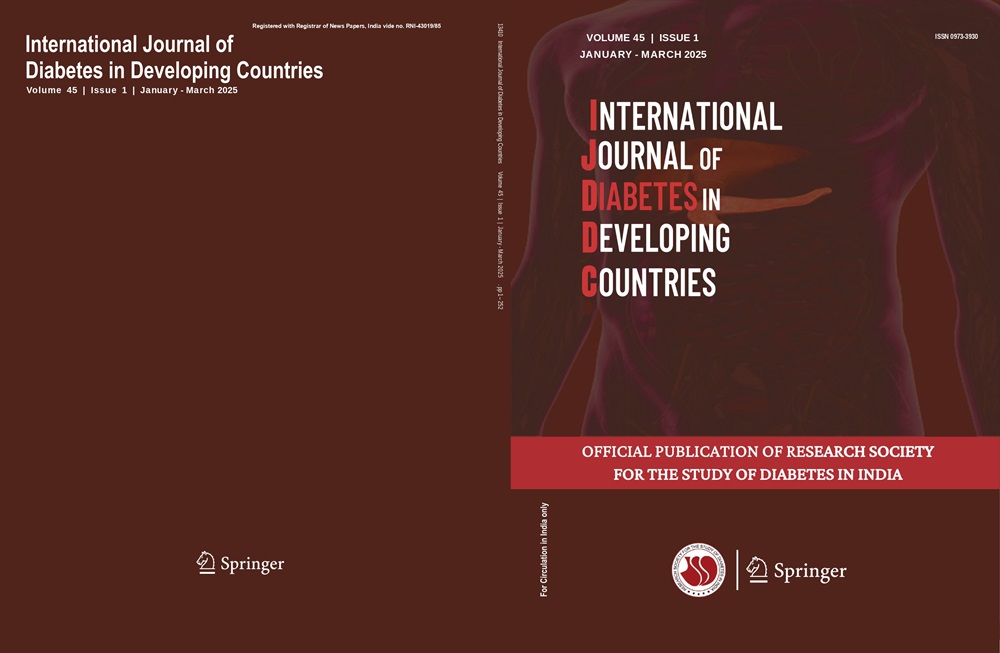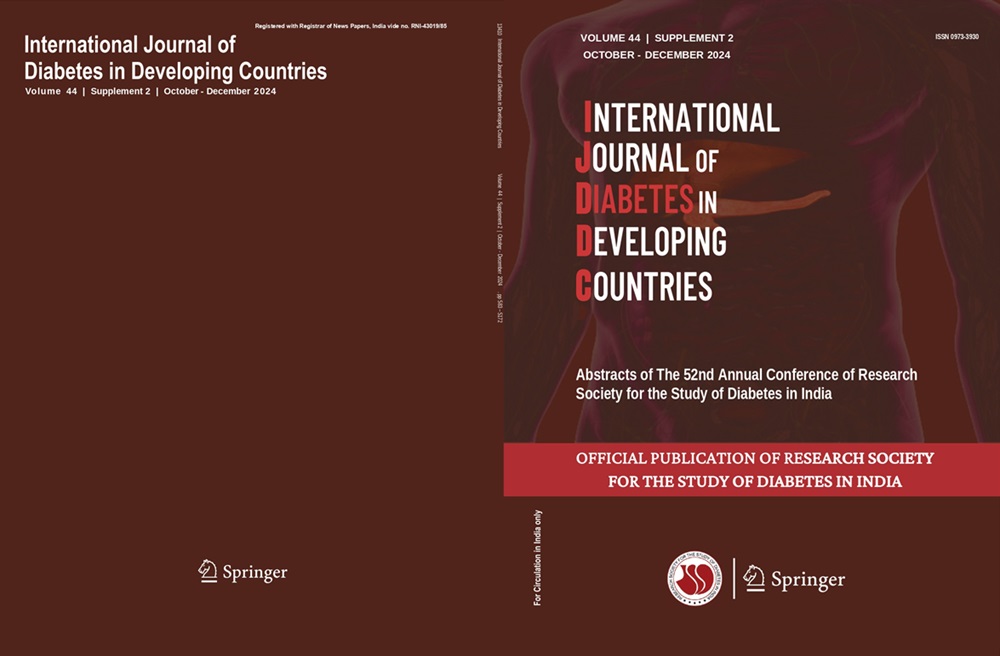Vijay Viswanathan, Reshma Mirshad
India faces a significant burden of diabetes-related complications, including both microvascular and macrovascular issues. As the prevalence of diabetes mellitus (DM) rises in the country, so does the number of people affected by these complications. Diabetic peripheral neuropathy (DPN) is particularly prevalent, affecting anywhere from 18.8 to 61.9% of individuals with DM in India [1]. Early detection of DPN is crucial for reducing associated complications. Implementing screening services at primary healthcare facilities can play a vital role in achieving early diagnosis and improving health outcomes for individuals with DM.
"Role of sensory feedback in postural control of the patients with diabetic neuropathy" by Reisi et al. [2] published in this current issue aimed to evaluate the role of sensory information in patients with type 2 diabetes. The study utilized stabilogram-diffusion analysis to evaluate balance in patients with T2DM, revealing distinct local and central modes of postural control. Notably, the parameter under assessment should exhibit random walk motion. Linear metrics indicated overall instability, particularly in the anterior–posterior (AP) direction, with greater instability observed in central control, which relies on sensory feedback. This finding underscores the impact of T2DM on sensory information crucial for posture. The study’s insights suggest that exercise programs aimed at improving posture in T2DM patients should prioritize proprioception, considering the compromised sensory function in this population.
“The relationship between neuron-specific enolase, high sensitivity C reactive protein, and diabetic peripheral neuropathy in Chinese patients with type 2 diabetes: A prospective nested case–control analysis” by Xie et al. [3] in this current issue explored the potential value of serum NSE and hs-CRP in predicting DPN in patients with type 2 diabetes. The findings suggest that higher serum NSE levels are associated with increased neuroinflammatory responses and can predict the development of diabetic peripheral neuropathy (DPN) in individuals with type 2 diabetes over an average of 5.1 years. NSE could potentially serve as a specific marker for neurological damage in DPN, offering valuable insights for early diagnosis and treatment strategies.
"Prospective study of clinical, biochemical, and radiological characteristics of diabetic Charcot neuroarthropathy at a tertiary care centre" by Aruna et al. [4] published in this current issue aimed to assess demographic, clinical, biochemical, radiological profile and treatment response in diabetic patients with Charcot neuroarthropathy (CN). The diabetic CN was found to be present in 0.49% of diabetic patients in the fifth to sixth decades of life with bilateral foot involvement in only 4% of patients. Diabetic patients developing CN had higher BMI, poor glycemic control, a longer duration of DM, and a higher prevalence of neuropathy and retinopathy complications. Early diagnosis and appropriate offloading lead to clinical remission in the majority of acute Charcot neuroarthropathy (ACN) and healing as well as prevention of foot ulceration in chronic Charcot neuroarthropathy (CCN).
"Changes of sweat gland function in type 2 diabetes mellitus patients with peripheral neuropathy" by Liu et al. [5] aimed to assess sweat gland function, analyze relevant damage indicators, and investigate autonomic nerve function impairment in patients with T2DM-DPN, potentially offering new diagnostic and treatment approaches. In the early stages of T2DM-DPN, many patients may not experience noticeable symptoms, making early screening and diagnosis crucial for effective treatment. Hence, tracking sweat gland function can aid in monitoring the progression of T2DM neuropathy. Accurate assessment of sweat gland function damage can enhance clinicians’ ability to moni-
tor autonomic neuropathy and accurately gauge the onset,
progression, and severity of T2DM-DPN.
“The importance of active B12 measurement in the diagnosis of vitamin B12 deficiency in type 2 DM patients using metformin” by Yildiz et al. [6] in this issue aimed to investigate the benefit of active B12 measurement in diagnosing B12 deficiency, as it might be a better alternative in the follow-up of B12 levels in type 2 DM patients using metformin. Higher doses of metformin, exceeding 1000 mg/day, were associated with a significant reduction in both total B12 and active B12 levels. There was also a negative correlation between the dose of metformin and these B12 levels.
The study highlighted the importance of closely monitoring patients with type 2 diabetes mellitus who are taking high doses of metformin for potential B12 deficiency.
All patients with diabetes should undergo screening for diabetic neuropathy using a recommended evidence-based screening algorithm. Patients with diabetes should undergo assessment for diabetic peripheral neuropathy (DPN) at the time of type 2 diabetes diagnosis and 5 years after the onset of type 1 diabetes, followed by annual evaluations thereafter [7].
A deeper understanding of additional risks, especially those that can be modified like components of MetS, is crucial in identifying diabetes patients who are most vulnerable to developing DPN. Recognizing these modifiable risks also paves the way for potential interventions aimed at slowing down the progression of DPN [8].
The current management of diabetic neuropathy emphasizes improving glycemic control in type 1 diabetes patients and lifestyle changes in type 2 diabetes patients, along with addressing neuropathic pain. For type 2 diabetes, the optimal therapeutic approach involves lifestyle modifications like diet and exercise, as well as managing lipid and blood pressure levels [9].
Overall, these studies contribute to our understanding of DPN and offer potential avenues for improving its diagnosis and management. Further research in this field is essential to develop more effective strategies for preventing and treating this debilitating complication of diabetes mellitus.
Reference
1. Jasmine A, Akila GV, Durai V, etal. Prevalence of peripheral neuropathy among type 2 diabetes mellitus patients in a rural health centre in South India. Int J Diabetes Dev Ctries. 2021;41:293–300.
https://doi.org/10.1007/s13410-020-00885-6.
2. Reisi A, Hashemi-Oskouei A, Ashtiani MN, etal. Role of sensory feedback in postural control of the patients with diabetic neu-
ropathy. Int J Diabetes Dev Ctries. 2023.
https://doi.org/10.1007/s13410-023-01200-9.
3. Xie J, Du R, Li Q, etal. The relationship between neuron-specifi cenolase, high sensitivity C reactive protein, and diabetic peripheral neuropathy in Chinese patients with type 2 diabetes: a prospective nested case–control analysis. Int J Diabetes Dev Ctries. 2023.
https://doi.org/10.1007/s13410-023-01212-5.
4. Aruna M, Kumar PR, Dash DK, etal. Prospective study of clinical, biochemical, and radiological characteristics of diabetic Char-
cot neuroarthropathy at a tertiary care centre. Int J Diabetes Dev Ctries. 2023.
https://doi.org/10.1007/s13410-023-01199-z.
5. Liu B, Cheng X, Chen M, et al. Changes of sweat gland function in type 2 diabetes mellitus patients with peripheral neuropathy. Int J Diabetes Dev Ctries. 2023.
https://doi.org/10.1007/s13410-023-01207-2.
6. Yıldız T, Yıldız S, Tunc M, etal. The importance of active B12 (holotranscobalamin) measurement in the diagnosis of vitamin B12 deficiency in type 2 DM patients using metformin. Int J Diabetes Dev Ctries. 2023.
https:// doi. org/ 10. 1007/s13410-023-01217-0.
7. ElSayed NA, Aleppo G, Aroda VR, Bannuru RR, Brown FM, Bruemmer D, Collins BS, Gibbons CH, Giurini JM, Hilliard ME, Isaacs D, Johnson EL, Kahan S, Khunti K, Leon J, Lyons SK, Perry ML, Prahalad P, Pratley RE, Seley JJ, Stanton RC, Sun JK, Gabbay RA, on behalf of the American Diabetes Association 12. Retinopathy, neuropathy, and foot care: standards of care in diabetes—2023. Diabetes Care. 2023;46(Supplement_1):S203–15.
https://doi.org/10.2337/dc23-S012.
8. Elafros MA, Andersen H, Bennett DL, Savelieff MG, Viswanathan V, Callaghan BC, Feldman EL. Towards prevention of diabetic peripheral neuropathy: clinical presentation, pathogenesis, and new treatments. Lancet Neurol. 2022;21(10):922–36.
https://doi.org/10.1016/S1474-4422(22)00188-0.PMID:36115364;PMCID:PMC10112836.
9. Feldman EL, Callaghan BC, Pop-Busui R, et al. Diabetic neuropathy Nat Rev Dis Primers. 2019;5:41.
https://doi.org/10.1038/s41572-019-0092-1.




